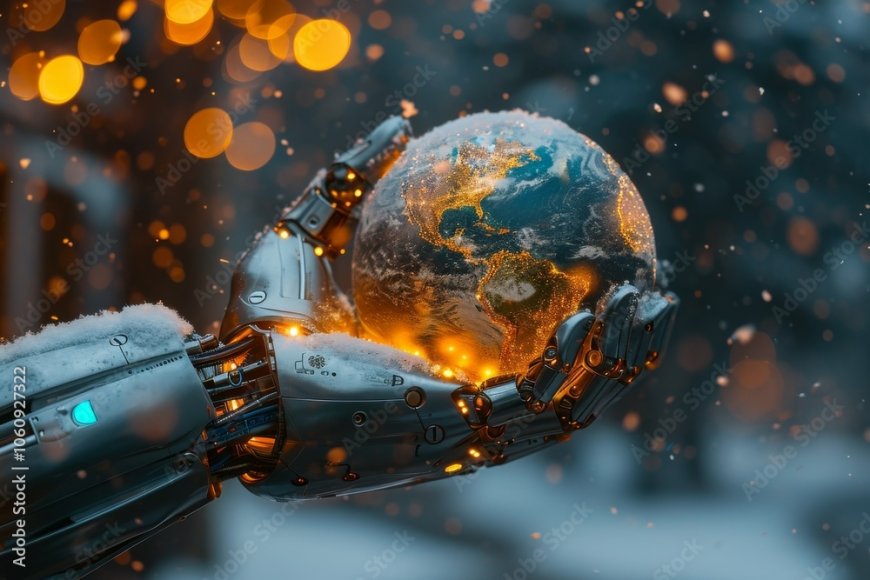How AI is Revolutionizing the Fight Against Climate Change
AI is playing a crucial role in combating climate change. Learn how artificial intelligence is optimizing renewable energy, reducing carbon emissions, and predicting extreme weather patterns.

Climate change is one of the most pressing global challenges of our time, and while traditional solutions play a vital role, Artificial Intelligence (AI) is emerging as a game-changer in tackling environmental issues. From predicting extreme weather patterns to optimizing renewable energy systems, AI is providing powerful tools to help mitigate and adapt to climate change.
As industries, governments, and scientists look for innovative ways to reduce carbon footprints and improve sustainability, AI-driven solutions are becoming increasingly crucial. But how exactly is AI making an impact? Let’s explore the ways AI is helping us combat climate change.
1. AI in Climate Prediction and Extreme Weather Forecasting
Accurate climate predictions are critical for policymakers, businesses, and communities to prepare for environmental shifts. AI-driven models analyze massive datasets from satellites, ocean buoys, and atmospheric sensors to detect patterns and predict future climate trends with greater accuracy.
- Early Warning Systems: AI-powered forecasting models can predict hurricanes, wildfires, and floods more accurately, allowing communities to prepare and minimize damage.
- Example: Google’s DeepMind is developing AI-based climate models that can predict extreme weather events faster and more accurately than traditional methods.
2. AI for Carbon Footprint Reduction
AI is helping industries identify inefficiencies and cut down on carbon emissions by optimizing energy use and production processes.
- Smart Grids & Energy Optimization: AI enhances electricity grids by predicting demand and optimizing the distribution of renewable energy.
- AI in Manufacturing: AI-driven analytics help industries reduce waste, improve supply chain efficiency, and lower emissions.
- Example: Microsoft’s AI for Earth initiative is using machine learning to track emissions, improve energy efficiency, and support sustainability projects worldwide.
3. AI in Renewable Energy Optimization
As the world shifts towards solar, wind, and hydro energy, AI is playing a crucial role in maximizing efficiency and reliability.
- Solar & Wind Energy Forecasting: AI models predict weather conditions to optimize solar panel and wind turbine performance.
- Grid Management: AI helps balance energy loads, ensuring that renewable energy sources provide stable power even with fluctuating weather conditions.
- Example: Google’s DeepMind AI has helped reduce energy consumption at data centers by 40% through intelligent cooling systems, making data-driven businesses more sustainable.
4. AI in Climate Science and Environmental Monitoring
AI is being used to analyze climate data at an unprecedented scale, helping researchers understand how climate change is evolving and how best to respond.
- Satellite Monitoring: AI processes vast amounts of satellite imagery to track deforestation, melting ice caps, and ocean pollution in real time.
- Biodiversity Conservation: AI-powered sensors and camera traps help track endangered species and combat illegal deforestation and poaching.
- Example: IBM’s Green Horizon project uses AI to predict air pollution levels and suggest interventions for cleaner cities.
5. AI-Powered Sustainable Agriculture
The agriculture sector is a major contributor to greenhouse gas emissions, but AI is helping farmers grow crops more efficiently while reducing environmental impact.
- Precision Farming: AI-driven analytics help farmers use water, fertilizers, and pesticides more efficiently, reducing waste.
- Drought & Pest Prediction: AI can predict weather patterns and monitor soil health, helping farmers prepare for droughts or pest invasions.
- Example: John Deere’s AI-powered farming equipment uses computer vision to distinguish between crops and weeds, reducing pesticide use by 90%.
6. AI in Climate Policy and Environmental Governance
AI is helping governments and policymakers develop better climate policies by analyzing massive datasets and predicting environmental trends.
- Tracking Corporate Emissions: AI can analyze satellite imagery and sensor data to monitor industries’ carbon emissions and enforce regulations.
- Sustainable Urban Planning: AI assists city planners in designing eco-friendly cities with optimized traffic flow and energy-efficient infrastructure.
- Example: The United Nations is leveraging AI to track deforestation and illegal mining in protected areas, holding corporations accountable for environmental damage.
7. AI for Carbon Capture and Climate Engineering
Emerging AI-driven technologies are being explored to actively remove carbon dioxide from the atmosphere and slow down global warming.
- Direct Air Capture (DAC): AI is optimizing carbon capture systems, making them more cost-effective and scalable.
- Geoengineering Simulations: AI models simulate climate engineering techniques to assess their feasibility and risks before implementation.
- Example: Companies like Climeworks use AI to improve carbon capture efficiency and remove CO₂ directly from the air.
Challenges & Ethical Concerns
Despite its potential, AI-driven climate solutions come with challenges:
- Energy Consumption: AI models require vast computing power, which can contribute to emissions if powered by fossil fuels.
- Data Bias & Accuracy: AI algorithms are only as good as the data they are trained on, and biased or incomplete data can lead to flawed predictions.
- Cost & Accessibility: Advanced AI solutions may not be accessible to developing nations, creating an imbalance in global climate action efforts.
However, by powering AI with renewable energy and improving data diversity, we can overcome these challenges and ensure AI remains a sustainable solution in the fight against climate change.
Conclusion: The Future of AI in Climate Action
Artificial Intelligence is no longer just a tool for business and technology—it is a critical asset in our fight against climate change. From optimizing renewable energy to predicting extreme weather, AI is accelerating sustainable solutions across industries.
With continued advancements in AI, we have a powerful ally in reducing emissions, protecting ecosystems, and building a greener future. However, global cooperation and ethical AI development will be key to ensuring that these technologies are used effectively and equitably.
As we step into the future, one thing is clear: AI is not just shaping our digital world—it is shaping the future of our planet.
What's Your Reaction?
 Like
0
Like
0
 Dislike
0
Dislike
0
 Love
0
Love
0
 Funny
0
Funny
0
 Angry
0
Angry
0
 Sad
0
Sad
0
 Wow
0
Wow
0



















































